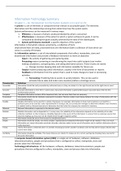Samenvatting
Information Technology Summary Ch. 1, 2, 4-8, 11-13
- Instelling
- Hogeschool Van Amsterdam (HvA)
Summary of Chapters, 1, 2, 4, 5, 6, 7, 8, 11, 12, 13 from the Principles of Business Information Systems book, for the Information Technology course.
[Meer zien]





